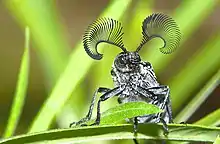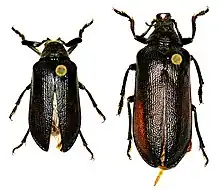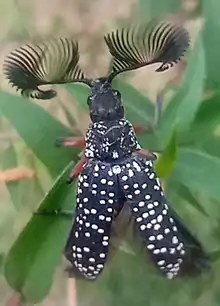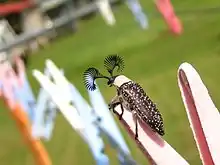Rhipiceridae
Rhipiceridae is a family of beetles found worldwide. The larva of rhipicerids are parasitoids of cicada nymphs. Rhipiceridae and Dascillidae form the super family Dascilloidea, within the Elateriformia.[1]
| Rhipiceridae | |
|---|---|
 | |
| Rhipicera carinata | |
| Scientific classification | |
| Domain: | Eukaryota |
| Kingdom: | Animalia |
| Phylum: | Arthropoda |
| Class: | Insecta |
| Order: | Coleoptera |
| Suborder: | Polyphaga |
| Infraorder: | Elateriformia |
| Superfamily: | Dascilloidea |
| Family: | Rhipiceridae Latreille, 1834 |
Taxonomic History
The taxonomic history of Rhipiceridae began with J. Fabricius who described Hispa mystacina in 1775,[1] which was later included in the new genus Rhipicera by Latreille (1817) who rightly noticed that the Fabrician species did not belong to Hispa and placed it in the tribe ‘Cebrionites’ along with Cebrio, Dascillus and Scirtes. Since then W. Kirby, J. O. Westwood and others described several new species of Rhipicera from Australia and South America.[1]
Subfamilies and Distribution
Rhipiceridae includes seven genera and about a hundred described species divided into two subfamilies, Rhipicerinae and Sandalinae. Sandalinae include most of the species and are known from North and South America, Africa, south-eastern Europe and Asia, while much less numerous Rhipicerinae, from Chile, New Caledonia and Australia, is a monophyletic lineage supported by several unambiguous apomorphies, like antennae composed of more than 11 antennomeres, relatively well developed maxillary galea and incomplete lateral pronotal carina.[1]
Ecology
The larval stages of riphicerids are external parasitioids on the nymphs of cicadas. In the species Sandalus niger, the eggs are deposited into the same holes and fissures in the bark of elm trees that cicadas deposit their eggs in. Subsequently, the first instars drop to the group alongside the cicada nymphs, and thereafter attach themselves to them. The abundance of adult rhipicerids tracks that of the emergence of adult cicadas.[2]
Genera
Rhipicerinae:
- Oligorhipis Guérin-Méneville, 1843 Australia, New Caledonia
- Polymerius Philippi, 1871 Chile
- Polytomus Dalman, 1819 southern South America
- Rhipicera Latreille, 1817 Australia
Sandalinae:
- Arrhaphipterus Schaum, 1862 Europe to Central Asia
- Chamoerhipis Latreille, 1834 Africa
- Sandalus Knoch, 1801 Americas, Asia, Africa
Gallery

 Rhicpicera femorata
Rhicpicera femorata Rhipicera mystacina
Rhipicera mystacina Rhipicera carinata - Western Australia
Rhipicera carinata - Western Australia Rhipicera carinata - Western Australia
Rhipicera carinata - Western Australia Rhipicera carinata
Rhipicera carinata Rhipicera carinata - antennae
Rhipicera carinata - antennae
References
- ZHENYU JIN; HERMES E. ESCALONA; ADAM ŚLIPIŃSKI; HONG PANG (June 2013). "PHYLOGENY AND CLASSIFICATION OF RHIPICERINAE (COLEOPTERA: RHIPICERIDAE) WITH A REVIEW OF THE AUSTRALIAN TAXA". Annales Zoologici. 63 (2): 275–317. doi:10.3161/000345413X669577. ISSN 0003-4541. Archived from the original on 19 February 2022. Retrieved 19 February 2022.
- "Rhipiceridae Latreille, 1834: Coleoptera, Beetles". Handbook of Zoology Online, edited by Andreas Schmidt-Rhaesa. Berlin, Boston: De Gruyter, 2016
Further reading
- Arnett, R.H. Jr.; Thomas, M. C.; Skelley, P. E.; Frank, J. H., eds. (2002). American Beetles, Volume II: Polyphaga: Scarabaeoidea through Curculionoidea. CRC Press. ISBN 978-0849309540.
- LeConte, J.L. (1861). Classification of the Coleoptera of North America. Smithsonian Miscellaneous Collections. Vol. 3. doi:10.5962/bhl.title.38459. ISBN 0665100558.
External links
 Media related to Rhipiceridae at Wikimedia Commons
Media related to Rhipiceridae at Wikimedia Commons